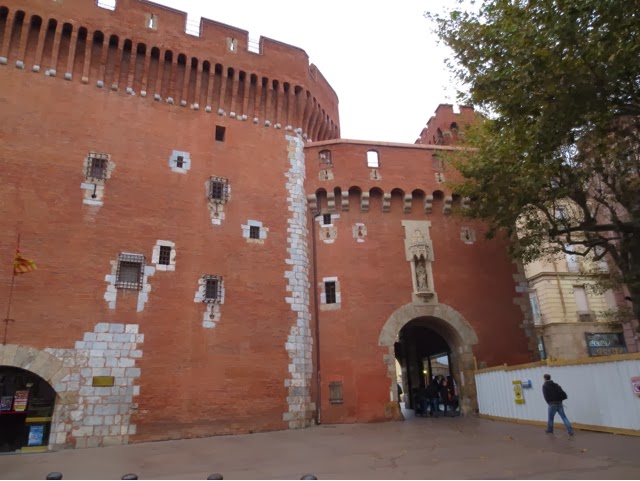When I researched Perpignan on the Internet, I found very mixed reviews on the place. Some people just loved it and others, not so much. I learned that Perpignan is half Catalan and half French (all the street signs are in both languages) and it is the last major town in the Languedoc region before the Spanish border. We both noticed the strong Spanish influence in the architecture. It is now home to many people from Algeria and Morocco who moved to France to escape repression in their own country.
Our walk from the train station into the town took us across this pretty scene - I think the canal is called La Basse.
We had intended to stop and visit the Castillet (below) which was first the city gate and then later a prison. Unfortunately, it was closed and I'm not sure why. The portal leads to the old city.
Just beside the Castillet, there was a very small patinoire or skating rink and the children sat in these sleighs that moved easily on the ice. It was fun to watch the people skating on such tiny surface.
Before I left, I had checked the weather in Perpignan. It was supposed to be to be cloudy and cool, but no rain. So, I decided to leave my umbrella at home because my back-pack is heavy enough on its own. Within an hour of our arrival, it began to rain. Where was my umbrella when I needed it? To avoid the rain, we decided to go for lunch. The restaurant I had read about and wanted to try was also closed on Saturdays at noon. Instead, we found a restaurant called le Divil in the city centre. I ordered the Poulet Fermier Facon cocotte à l'ancienne with a glass of the house red which was excellent.
After a lovely lunch, we decided to brave the elements and see some of the sights of Perpignan. En route to the cathedral, we came across this scene and I just had to take a picture. Artificial snow was used to make it look "Christmasy" I guess. It was a little unusual for this Canadian.
The Cathédrale wasn't particularly interesting to me and I found parts of the interior quite ornate and gaudy. However, the ceiling was rather nice. Beside the cathédrale was the Campo Santo which is the only cloistered cemetery in France. Once again, to me it was rather non-descript. There are four galleries with long rows of white marble Gothic porticos.
From there, we made our way to the Casa Xanxo which was the private house of a rich draper named Bernut Xanxo. It was built during the 16th century and today houses art expositions. We had a chance to see the "Perpignan Romantique" exhibition which featured Catalan costumes, jewellry, paintings and photographs from 1815-1848. The building also had a charming courtyard. Here is a picture which gives you a glimpse of just how old this building is. Apparently, it is one of the only Gothic houses that was conserved in Perpignan.
Last tourist stop was the Palais des rois de Majorgue. As is the case in most of the places I visited, you walk uphill and once you arrive, the winds begin to howl. I thought we might get a good view of the city, countryside and the mountains from the palace, but it was not meant to be. It was cloudy and foggy and not picture worthy today.
This palace was originally the king's residence and its constuction began in 1276. We were a little pressed for time, so we did not go into the palace for a visit. From what I had read, the most note worthy parts to visit anyway, were the gardens and the courtyard. An orange tree outside the palace.
It was late afternoon so we started to make our way back to the train station. Here are a few of the things we saw along the way.
Some of the many palm trees in Perpignan.
I loved the lush green plants and flowers growing on the balconies of this apartment and to think it is November 30!
Both Magda and I thought Perpignan was a rather pretty place with narrow streets, interesting architecture and friendly people. Magda thought it was quieter and less busy than Montpellier and I concur. Perhaps if we had had more time and the weather had cooperated, we would have also visited a nearby fishing village called Collioure that our prof Caroline said was very picturesque.
I'm going to end this blog with a picture of Père Noël. Patricia tells me that many of the cities in the south of France are hosting "le marché de Noël" and Perpignan is no exception. I saw my first Père Noël with a little girl and took his picture. In my next blog, I'll tell you more about "le marché de Noël". Until then..
































































